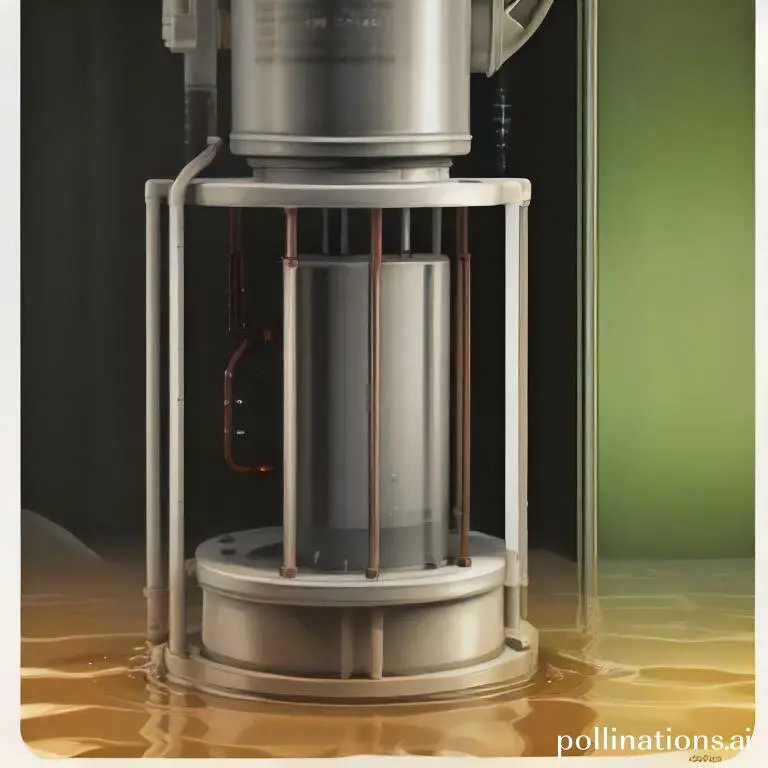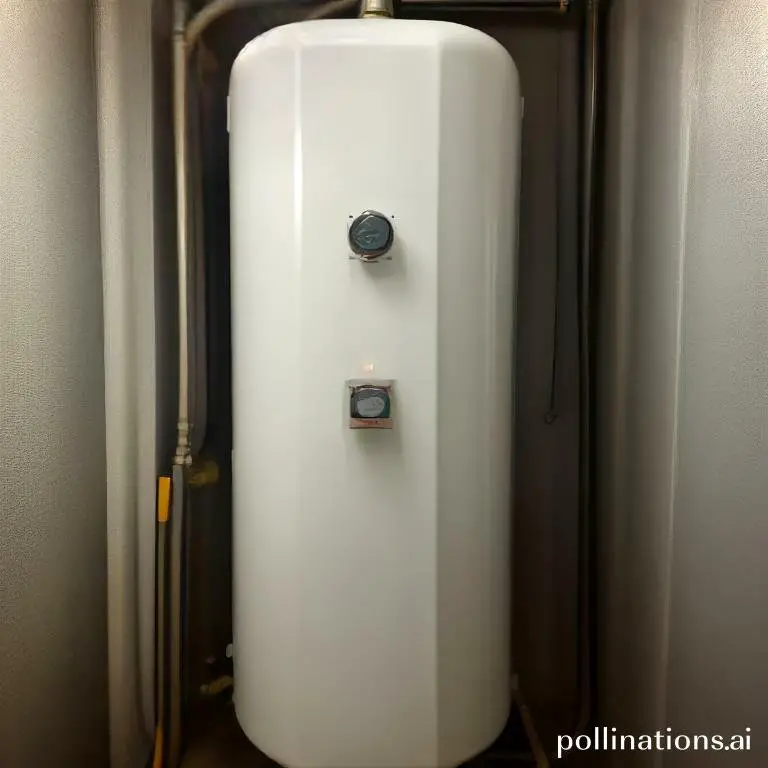
II. Regular sediment removal can improve energy efficiency and prolong the lifespan of water heaters.
III. Sediment removal can be done through flushing the tank or using a sediment removal system.
Sediment removal plays a crucial role in maintaining the efficiency and performance of water heaters. Over time, mineral deposits can accumulate in the tank, hindering heat transfer and reducing energy efficiency.
By regularly removing sediment, homeowners can ensure that their water heaters operate at optimal levels, saving both energy and money. This process involves flushing out the tank to remove any built-up sediment, allowing for improved heat transfer and overall performance.
With sediment removal, homeowners can enjoy energy-efficient water heaters that provide reliable hot water for their daily needs.
Signs of sediment buildup in water heaters
Water heaters are essential appliances in our homes, providing us with hot water for various purposes. Nevertheless, over time, sediment buildup can occur, leading to various issues. Realizing the signs of sediment buildup, you can take necessary actions to maintain the efficiency and longevity of your water heater.
1. Decreased hot water supply
One of the first signs of sediment buildup in water heaters is a decrease in hot water supply. As sediment settles at the bottom of the tank, it takes up space, reducing the volume available for hot water. If you notice that your showers are becoming shorter or your faucets are not producing as much hot water as before, sediment buildup may be the culprit.
2. Strange noises from the water heater
Another indication of sediment buildup is strange noises coming from the water heater. As water is heated, the sediment can create a barrier between the heating element and the water, causing the heater to work harder and produce unusual sounds. If you hear popping, cracking, or rumbling noises, it’s a clear sign that sediment buildup is affecting your water heater’s performance.
3. Discolored water
Discolored water is not only unappealing but also a potential sign of sediment buildup. As the sediment accumulates, it can mix with the water, resulting in a yellowish or brownish tint. If you notice a change in the color of your hot water, it’s essential to address the issue promptly to prevent further damage to your water heater and ensure clean, clear water.
4. Higher energy bills
Sediment buildup can also lead to higher energy bills. As the sediment insulates the heating element, the water heater needs to use more energy to heat the water adequately. This increased energy consumption can cause a noticeable spike in your monthly energy bills. By confronting sediment buildup, you can improve the efficiency of your water heater and potentially reduce your energy costs.
Regular maintenance and periodic flushing of your water heater can help prevent sediment buildup and prolong its lifespan. If you find any of these signs of sediment buildup, it’s advisable to consult a professional plumber to assess the situation and perform the necessary maintenance or repairs.
| Signs of Sediment Buildup | Possible Causes | Solutions |
|---|---|---|
| Decreased hot water supply | Sediment settling at the bottom of the tank | Flush the water heater to remove sediment |
| Strange noises from the water heater | Sediment creating a barrier between the heating element and the water | Flush the water heater to remove sediment |
| Discolored water | Sediment mixing with the water | Flush the water heater to remove sediment |
| Higher energy bills | Sediment insulating the heating element | Flush the water heater to remove sediment |
Methods for Sediment Removal
Sediment buildup in a water heater can lead to various issues, such as reduced efficiency and potential damage to the unit. To ensure optimal performance and prolong the lifespan of your water heater, imperative to regularly remove sediment. Here are three effective methods for sediment removal:
1. Flushing the Water Heater
Flushing the water heater is a simple yet effective method to remove sediment. Begin by turning off the power supply to the heater and allowing it to cool down. Next, locate the drain valve at the bottom of the tank and attach a hose. Place the other end of the hose in a suitable drainage area or container. Open the valve and allow the water to flow out, flushing away the sediment along with it. Repeat this process until the water runs clear.
2. Using a Descaling Solution
If flushing alone does not completely remove the sediment, using a descaling solution can be an excellent option. Start by turning off the power and allowing the heater to cool down. Mix the descaling solution according to the manufacturer’s instructions. Attach a hose to the drain valve and place the other end in a suitable drainage area. Open the valve and drain a small amount of water from the tank. Carefully pour the descaling solution into the tank and let it sit for the recommended amount of time. Afterward, flush the tank by opening the valve and draining the solution. Rinse the tank thoroughly by repeating the flushing process until the water runs clear.
3. Hiring a Professional Plumber
In some cases, sediment buildup may be particularly stubborn or the water heater may require additional maintenance. Hiring a professional plumber with experience in water heater maintenance can ensure thorough sediment removal. A skilled plumber will have the necessary tools and expertise to effectively clean the tank and ensure optimal performance.
Regular sediment removal is essential to maintain the efficiency and longevity of your water heater. Whether you choose to flush the tank, use a descaling solution, or seek professional assistance, maintaining a sediment-free water heater will help you enjoy reliable hot water and save on energy costs in the long run.
Flushing the Water Heater
Flushing the water heater is an essential maintenance task that helps ensure its optimal performance and energy efficiency. By removing sediment buildup, you can extend the lifespan of your water heater and improve its heating capabilities. In this section, we will guide you through the necessary steps to flush your water heater effectively.
1. Steps for Flushing the Water Heater
Flushing your water heater involves a simple yet important process. Follow these steps to get started:
- Turn off the power supply to the water heater. This can be done by switching off the circuit breaker dedicated to the heater or turning off the gas valve.
- Attach a hose to the drain valve located at the bottom of the water heater. Make sure the other end of the hose is directed towards a suitable draining area.
- Open the pressure relief valve on the water heater to prevent vacuum formation during the flushing process.
- Open the drain valve and let the water flow out through the hose. Be cautious as the water may be hot.
- Allow the water to drain fully until it runs clear, indicating the removal of sediment.
- Close the drain valve and remove the hose.
- Turn on the water supply to the heater and let it fill completely before restoring power or relighting the pilot light.
2. Tools Required for Flushing
Before you begin flushing your water heater, gather the necessary tools:
- A garden hose long enough to reach a suitable draining area.
- A pair of pliers or a wrench to open and close the drain valve.
3. Precautions to Take Whilst Flushing
At the same time flushing your water heater, it’s important to keep the following precautions in mind:
- Ensure the power supply to the water heater is turned off to prevent any accidents.
- Handle the hot water carefully to avoid burns. Allow it to cool down before proceeding.
- Use caution when opening and closing the drain valve to prevent any leaks or damage.

Using a Descaling Solution
1. Types of Descaling Solutions
In the realm of descaling your appliances, integral to choose the right descaling solution for effective results. There are different types of descaling solutions available in the market, each designed for specific purposes:
- Lemon Juice Solution: This natural and eco-friendly solution is perfect for removing lime scale buildup in your appliances. The citric acid in lemon juice dissolves the mineral deposits, leaving your appliances clean and functioning optimally.
- Vinegar Solution: Vinegar is a versatile descaling solution that can be used for various appliances. Its acetic acid content helps break down mineral deposits and remove stubborn stains.
- Citric Acid Solution: Citric acid is a powerful descaling agent that effectively removes limescale without causing any harm to your appliances. It is commonly used for coffee makers, kettles, and other small appliances.
2. Steps for Using a Descaling Solution
Follow these steps to use a descaling solution properly:
- Read the Appliance Manual: Before starting the descaling process, refer to the appliance manual for specific instructions and recommendations.
- Mix the Solution: Prepare the descaling solution as per the instructions provided. Dilute the solution with water if necessary.
- Empty and Clean the Appliance: Empty the appliance of any remaining liquid or residues. Clean the removable parts separately.
- Apply the Solution: Pour the descaling solution into the appliance’s water reservoir or designated area. Ensure the solution covers all the affected surfaces.
- Let it Sit: Allow the descaling solution to sit in the appliance for the recommended time mentioned in the manual.
- Rinse Thoroughly: After the recommended time, thoroughly rinse the appliance with clean water to remove any traces of the descaling solution.
- Run a Cleaning Cycle: Some appliances, such as coffee makers, may require running a cleaning cycle with fresh water to ensure all the descaling solution is flushed out.
3. Precautions to Take In the course of Using a Descaling Solution
At the same time using a descaling solution, it is essential to take certain precautions to ensure safety and avoid any damage to your appliances:
- Protective Gear: Wear gloves and protective eyewear to prevent any contact with the descaling solution.
- Ventilation: Ensure the area is well-ventilated to avoid inhaling any fumes from the solution.
- Follow Instructions: Always follow the instructions provided with the descaling solution and the appliance manual for the correct usage.
- Test Compatibility: Before using a descaling solution, check if it is compatible with your appliance to avoid any damage.
- Thorough Rinsing: After the descaling process, make sure to rinse the appliance thoroughly to remove any residue.
| Descaling Solution | Best For |
|---|---|
| Lemon Juice Solution | Lime scale buildup |
| Vinegar Solution | Various appliances |
| Citric Acid Solution | Coffee makers, kettles, small appliances |

Hiring a Professional Plumber
In regard to plumbing issues, hiring a professional plumber is essential to ensure the job is done right. Whether you have a leaky faucet, a clogged drain, or a burst pipe, a professional plumber has the expertise and experience to resolve the problem efficiently and effectively.
Benefits of Hiring a Professional Plumber
There are numerous benefits to hiring a professional plumber for your plumbing needs:
- Expertise: Professional plumbers have the knowledge and skills to handle a wide range of plumbing issues. They are trained in the latest techniques and technologies, ensuring that the problem is diagnosed and fixed correctly.
- Time and Cost Savings: Hiring a professional plumber can save you time and money in the long run. They can quickly identify the root cause of the problem and provide a lasting solution, preventing further damage and costly repairs.
- Quality Workmanship: Professional plumbers take pride in their work and strive to deliver high-quality results. They adhere to industry standards and use the right tools and materials to ensure a job well done.
- Emergency Services: Plumbing emergencies can happen at any time. Professional plumbers offer 24/7 emergency services, providing peace of mind and prompt assistance when you need it the most.
Factors to Consider During Hiring a Plumber
When hiring a professional plumber, fundamental to consider the following factors:
- License and Insurance: Ensure that the plumber is licensed and insured. This guarantees that they have met the necessary requirements and are covered in case of any unforeseen incidents.
- Experience and Reputation: Look for a plumber with years of experience and a good reputation in the industry. Check online reviews and ask for referrals to gauge their reliability and quality of work.
- Availability and Responsiveness: Plumbing issues can arise unexpectedly, so fundamental to hire a plumber who is readily available and responsive to your calls. Prompt communication and timely service are crucial.
- Pricing and Estimates: Obtain multiple quotes from different plumbers to compare pricing and ensure transparency. Be wary of extremely low or high prices, as they may indicate subpar work or hidden charges.
Cost of Hiring a Professional Plumber
The cost of hiring a professional plumber varies depending on several factors, including the complexity of the job, the materials required, and the plumber’s experience. It is recommended to request a detailed estimate before commencing any work to avoid surprises.
| Service | Estimated Cost |
|---|---|
| Leaky Faucet Repair | $100 – $200 |
| Clogged Drain Cleaning | $80 – $150 |
| Burst Pipe Repair | $200 – $500 |
Bottom Line
Removing sediment from your water heater is crucial for maintaining its efficiency and prolonging its lifespan. Sediment buildup can cause your water heater to work harder, use more energy, and ultimately fail sooner. Regular maintenance, such as flushing the tank and installing a sediment filter, can help prevent sediment buildup and save you money on energy bills. Additionally, choosing an energy-efficient water heater can further reduce your energy usage and costs. By taking these steps, you can ensure that your water heater is running at its best and providing you with reliable hot water for years to come.
Overall, sediment removal is a simple yet important aspect of water heater maintenance that can have a significant impact on your energy usage and costs. By staying on top of this task and investing in an energy-efficient water heater, you can enjoy reliable hot water meanwhile also saving money and reducing your environmental footprint.
Read More:
1. Sediment Removal And Water Heater Maintenance Cost
2. Sediment Removal Impact On Water Heater Safety










